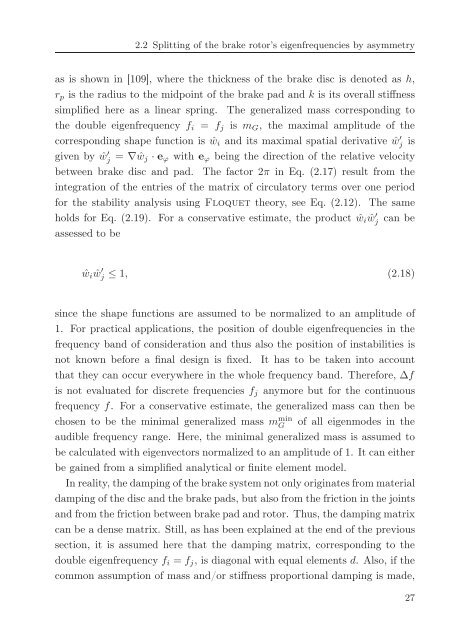Avoidance of brake squeal by a separation of the brake ... - tuprints
Avoidance of brake squeal by a separation of the brake ... - tuprints
Avoidance of brake squeal by a separation of the brake ... - tuprints
Create successful ePaper yourself
Turn your PDF publications into a flip-book with our unique Google optimized e-Paper software.
2.2 Splitting <strong>of</strong> <strong>the</strong> <strong>brake</strong> rotor’s eigenfrequencies <strong>by</strong> asymmetry<br />
as is shown in [109], where <strong>the</strong> thickness <strong>of</strong> <strong>the</strong> <strong>brake</strong> disc is denoted as h,<br />
r p is <strong>the</strong> radius to <strong>the</strong> midpoint <strong>of</strong> <strong>the</strong> <strong>brake</strong> pad and k is its overall stiffness<br />
simplified here as a linear spring. The generalized mass corresponding to<br />
<strong>the</strong> double eigenfrequency f i = f j is m G , <strong>the</strong> maximal amplitude <strong>of</strong> <strong>the</strong><br />
corresponding shape function is ŵ i and its maximal spatial derivative ŵ j ′ is<br />
given <strong>by</strong> ŵ j ′ = ∇ŵ j · e ϕ with e ϕ being <strong>the</strong> direction <strong>of</strong> <strong>the</strong> relative velocity<br />
between <strong>brake</strong> disc and pad. The factor 2π in Eq. (2.17) result from <strong>the</strong><br />
integration <strong>of</strong> <strong>the</strong> entries <strong>of</strong> <strong>the</strong> matrix <strong>of</strong> circulatory terms over one period<br />
for <strong>the</strong> stability analysis using Floquet <strong>the</strong>ory, see Eq. (2.12). The same<br />
holds for Eq. (2.19). For a conservative estimate, <strong>the</strong> product ŵ i ŵ j ′ can be<br />
assessed to be<br />
ŵ i ŵ ′ j ≤ 1, (2.18)<br />
since <strong>the</strong> shape functions are assumed to be normalized to an amplitude <strong>of</strong><br />
1. For practical applications, <strong>the</strong> position <strong>of</strong> double eigenfrequencies in <strong>the</strong><br />
frequency band <strong>of</strong> consideration and thus also <strong>the</strong> position <strong>of</strong> instabilities is<br />
not known before a final design is fixed. It has to be taken into account<br />
that <strong>the</strong>y can occur everywhere in <strong>the</strong> whole frequency band. Therefore, ∆f<br />
is not evaluated for discrete frequencies f j anymore but for <strong>the</strong> continuous<br />
frequency f. For a conservative estimate, <strong>the</strong> generalized mass can <strong>the</strong>n be<br />
chosen to be <strong>the</strong> minimal generalized mass m min<br />
G<br />
<strong>of</strong> all eigenmodes in <strong>the</strong><br />
audible frequency range. Here, <strong>the</strong> minimal generalized mass is assumed to<br />
be calculated with eigenvectors normalized to an amplitude <strong>of</strong> 1. It can ei<strong>the</strong>r<br />
be gained from a simplified analytical or finite element model.<br />
In reality, <strong>the</strong> damping <strong>of</strong> <strong>the</strong> <strong>brake</strong> system not only originates from material<br />
damping <strong>of</strong> <strong>the</strong> disc and <strong>the</strong> <strong>brake</strong> pads, but also from <strong>the</strong> friction in <strong>the</strong> joints<br />
and from <strong>the</strong> friction between <strong>brake</strong> pad and rotor. Thus, <strong>the</strong> damping matrix<br />
can be a dense matrix. Still, as has been explained at <strong>the</strong> end <strong>of</strong> <strong>the</strong> previous<br />
section, it is assumed here that <strong>the</strong> damping matrix, corresponding to <strong>the</strong><br />
double eigenfrequency f i = f j , is diagonal with equal elements d. Also, if <strong>the</strong><br />
common assumption <strong>of</strong> mass and/or stiffness proportional damping is made,<br />
27

















